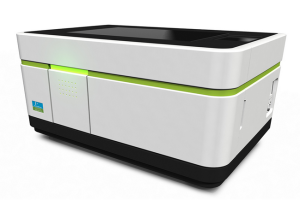Overview:
Service contact (administrators only): "EVO Portal", Perkin Elmer website.
Incubation: Heating available. CO2 controller planned-to-be-available. No humidity control: Use closed samples in excessive imaging buffer, if necessary.
Objectives: 5x, 20x, 40x (all air).
Light/optics: 4x LED light source (can activate only 1 source at the same time), 4x emission filter (UV / green / red / far-red), Spinning disc optics. 1x top-down-LED (740 nm, for morphology, using transparent-top samples).
Camera: 4.7 Megapixel sCMOS.
Light path/wavelengths
Excitation windows available:
- 365 nm (340-380 nm)
- 475 nm (460-490 nm)
- 550 nm (535-565 nm)
- 630 nm (615-645 nm)
Detection windows available:
- 430-520 nm (blue)
- 500-550 nm (green)
- 570-650 nm (red)
- 665-760 nm (far-red)
What about my specific excitation line?
For fluorophores with an excitation peak at for example 510, use the closest available light source: 475 nm
Plates:
- Manufacturer comments on plate usage: https://www.perkinelmer.com/uk/lab-products-and-services/application-support-knowledgebase/microplates/microplates-knowledge-base.html
- Machine takes "all" available cover-slip bottomed plates.
- But, do not use Techno Plastic Products (yellow stripe); which have plate-vents and cannot be supported by the holder.
- may have a glass or plastic "coverslip" bottom
- for good cell-attachment, can coat the bottom with poly-L-lysine
- When correctly entered, objectives will never touch the plate bottom (if still; plate will be pushed upwards).
Skirt height
Difference between plate-edge height, and imaging surface height
Important value to enter into machine: 0-1.5 mm range allowed.
Can measure the height of unknown plates using the Operetta with the 20x objective.
Edge effects
Prefer not to use the outer rows and outer columns of any given plate.
This because of "edge effects" (thermal, evaporation, different near the plate edge).
Fill those wells with only buffer, for example, and do not use for imaging.
Usage
Around the sample area:
- If the table is not powered, eject/re-insert he plate holder (software). Do not manually move table.
- Plate/sample holder is mounted on steel tracks: DO NOT CLEAN/TOUCH (if dirty, call service)
- Plate/sample holder contains a "penta-pattern" of dots, used internally for high-accuracy positioning of sample.
- Red dot on objectives needs to match the red dot on the microscope. Objectives can be manually lifted out of the system.
- With open lid, the machine counts as a class 3B laser. Close the door firmly.
- Emergency release hatch button (lid open) is on the lower right of the machine.
Plate loading:
- Start Harmony software
- Log-in with user account: personal account, with personal settings
- User accounts can only delete own data. Administrators can delete all.
The whole system is process-oriented
(re)configuration and data generation are alternating.
- Choose plate. Nomenclature = number of wells, manufacturer, type/name of plate
- Choose objective. Start at eg. 20x / 0.4 NA
- Choose operational mode (opt-mode). Confocal = spinning disc mode, with pinholes, 5% transmission of light, both ways. Epi = non-confocal, 100% transmission of light, both ways.
- Binning: (makes image size <4.7 Megapixel) → signal x4, noise x2, resolution significantly reduced.
- Live preview: eg. Show current image during stack acquisition. off = evaluate manually after setting up acquisition.
- Click "new" → new experiment.
- Set up individual channels for your fluorophores.
Arrowheads
Located under menus always reveal more detailed settings.
- Plate layout (right-most). Select wells to measure, click "SELECT". Select FOV, number, position.
- Select well-to-test.
- Clean plate-bottom with KimTech wipe and 70% Ethanol before use.
- Load plate (place within protrusions).
- or: Load slides in holder.
- or: Load slide holder into Operetta.
Setting up for imaging:
- Evaluate brightness; auto-scale and auto-contrast are always applied.
- No range-indicator (over/under exposure) is available, but a histogram for each channel is displayed
- Scaling: Normal mode: Black-to-Colour. Enhanced mode: Black-to-Colour-to-White.
- Right-click on the sample image, "show intensity". Ctrl + Click to add ROIs.
- Find focus height: Z-stack!
- Start at negative values. Go up to positive. See in "TEST IMAGES" (right of screen)
- Pick the right focus height for each channel individually.
- Next, to be certain, do focus finding in another cell. Possible plate-tilting may be revealed, and needs inspection.
Z-stacks yes/no?
It is possible to disable "use z-stack in test", to test with only single-plane images
If you want no stack acquisition upon running the actual experiment, simply select "0 planes"
- Overview picture: in the "well layout" section, select all interesting wells; right click "overview;" preview field: observe the stitched image afterwards.
- The overview picture is automatically downscaled to 200 MB in size; full-resolution stitching is not supported.
- Double-check overlap: Pull up the contrast to an extreme value (visually; right-click in the image)
- Determine whether flat-field correction will be necessary.
- "online-job" = perform image analysis during acquisition
- You can add layouts (labels) to the output data. This is an additional table.
- Re-use a plate layout (saved, from eg. editor or previous experiment); "Assay" in "define layout" (right-most).
Use overview image to pick interesting regions
Using "Test Images", and marking regions, right-click and "use as background for well" for a visual aid for selecting further regions.
Run the experiment:
- Evaluate that the correct assay is loaded.
- Name the plate and add keywords.
- → Start! And observe live-preview images during acquisition (when enabled)
- Select the whole plate, right-click, organise images in "realistic" (corresponding to the plate) or "packed" (best for display) layouts
Flat-field correction
The software can do flat-field correction based on acquired images, provided that foreground/background and areas without cells are present.
This also works in wells filled with tissue, or more-than-confluent cell cultures.
- When done: open the lid (settings - Operetta CLS - open) and remove plate/slide holder.
Image processing and analysis:
Loose info pieces:
Z-steps always > 100 nm
Fluorescent staining strategy:
To facilitate auto-detection in subsequent image analysis steps:
a) stain cells with target marker
b) stain cytosol separately (eg. CellMask Blue)
c) stain nuclei separately
Computer attached to the microscope:
DO NOT SWITCH OFF!
The PC is running a live image data and image analysis server.

